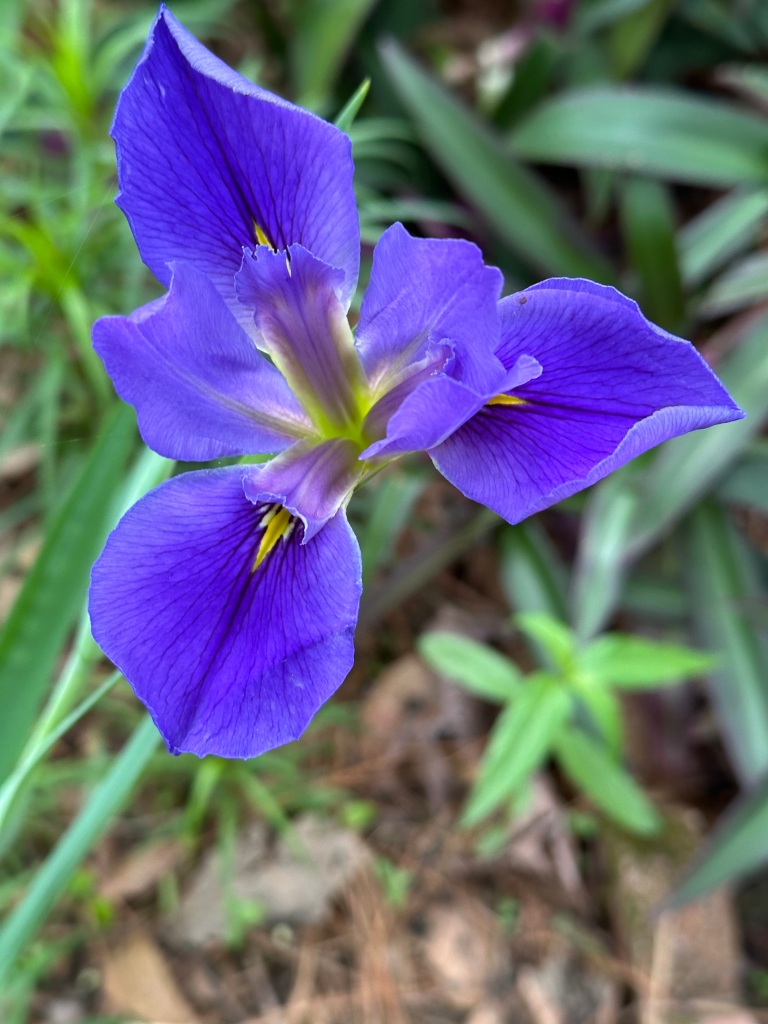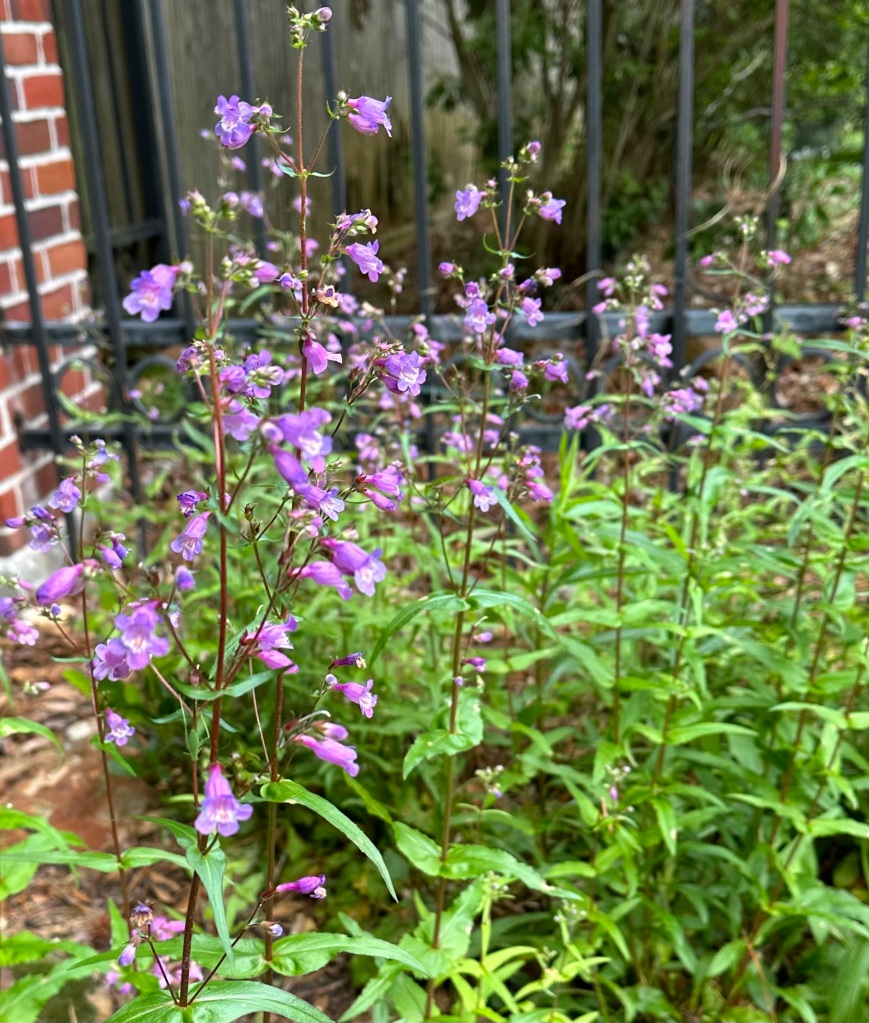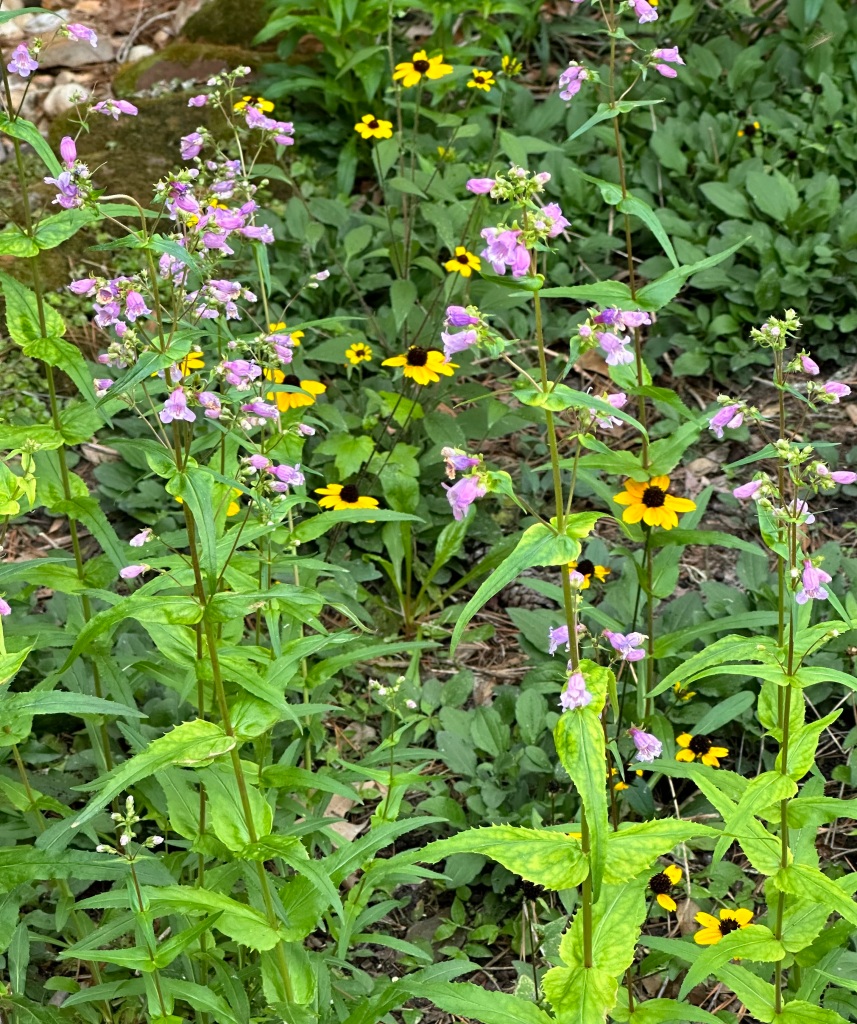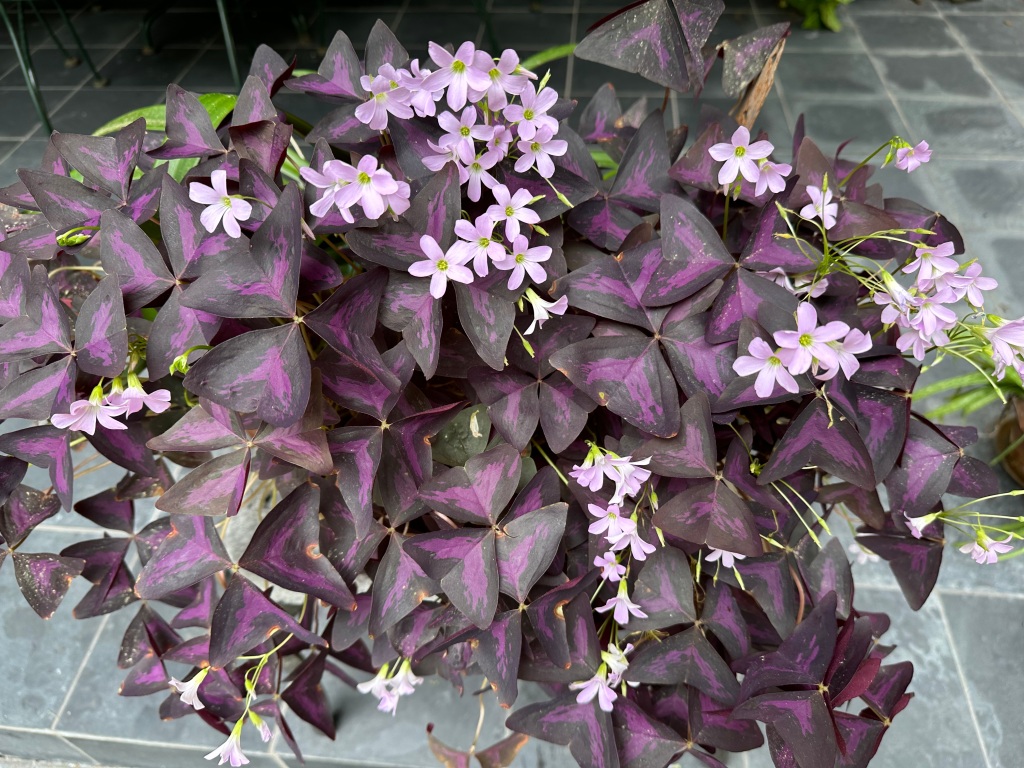Finally Flowers!
Posted: April 1, 2024 Filed under: Gardening | Tags: African Hosta, Automatic Gardening, cannas, Drimiopsis maculata, Gulf Coast gardening, Gulf Coast Penstemon, Little White Soldiers, purple Oxalis, Year-round gardening 27 Comments
I’ve been slightly jealous of my northern gardener friends’ pictures of daffodils, forsythia, hellebore, and other early bloomers. My plants are finally coming back from the freeze and there are a few in bloom. Above is my “mulch pile” Iris. The Iris arrived in a mulch delivery over 30 years ago and proved to be very hardy. It has managed to reproduce too.

White Soldiers or Drimiopsis maculata is a great plant for this area. It is reliable and spreads. The flowers are not that exciting and after the bloom, they will make bulblets and new plants. They are also called African Hosta and are the closest to a Hosta we can grow here.

One of Cannas has bloomed already. Another plant that reproduces easily.

The Gulf Coast Penstemon is really putting on a show. The only thing is that I did not plant them in this bed.

Black-eyed Susans have also started to flower and make a nice spring mix with the Gulf Coast Penstemon.

The Purple Oxalis is having a very happy spring. These are in two pots I have next to each other and they make a great display. I also have the Oxalis in two beds and they always come back every year.
Just Leaves
Posted: August 22, 2023 Filed under: Gardening | Tags: African Hosta, Chocolate Plant, Drimiopsis maculata, hardy begonia, Hypoestes phyllostachya), Japanese Fern, ligularias, Peacock Ginger, Polka Dot Plant, Pseuderanthemum alatum - 16 CommentsSometimes leaves are enough. All of these plants are perennials in my garden and very much appreciated for their ability to come back every year. Pick your favorite.

Hardy Begonia



Peacock Gingers

African Hosta or Drimiopsis

Chocolate Plant

Japanese Fern

Ligularias


Polka Dot Plant
Spring Has Finally Sprung
Posted: April 18, 2022 Filed under: Gardening | Tags: Black Eyed Susan Vine, Drimiopsis maculata, Dutchman's Pipe, Gulf Coast Penstemon, Justicia brandegeeana, Monarch caterpillar, Ruby Throated Hummingbird, shrimp plant, Thungergia alata 22 Comments
It is finally starting to feel like spring and the flowers have begun to bloom. I remember the first time I ever saw Shrimp Plant and thought it was the most fantastical plant ever. I vowed I would grow it one day when I finally had a yard. This one is a passalong from my mother-in-law. I think of her every time I look at it. Hummingbirds love it too.

In our wet hot weather, we cannot grow those glorious big hostas that are featured in plant catalogs but we can grow African False Hostas (Drimiopsis maculata) also called Little White Soldiers, Leopard Plant, Injoba, or as I like to call it, Spotted Dick for the cute spots on the leaves. Why Spotted Dick? Mostly because I couldn’t remember Drimiopsis maculata and I find the name Spotted Dick, an English pudding in a can, really funny. Here is a youtube video on Spotted Dick. https://www.youtube.com/watch?v=qE3jSGGsVbk.

The Black-Eyed Susan Vine (Thunbergia alata) is blooming nicely although it completely missed the fence it was to climb on.

I have Gulf Coast Penstemon growing in three different places and all are doing well. The hummingbirds finally have natural food. The Rufous hummer is still hanging out and two Ruby-Throated hummingbirds have arrived from their winter homes.

The Dutchman’s Pipe has been growing lots of new leaves. I moved the vine a bit and to my surprise I found a flower blooming. It seems that we went from cold wintery weather (wintery for here) with sad freeze damage to a sudden burst of spring in just a few days.

And just to top off our sudden spring, I found these two fat Monarch caterpillars munching on the Butterfly Weed.
Hooray for the Automatic Garden
Posted: March 9, 2021 Filed under: Uncategorized | Tags: Automatic Gardening, Bluebonnets, cannas, Drimiopsis maculata, gingers, Gulf Coast gardening, Mealy Blue Sage, Oxalis Triangularis, purple Oxalis, snowflakes, Southern Gardening, Subtropical Gardening 20 Comments—————————
It has been a little more than two weeks since our epic freeze. The Automatic Garden is pulling through and plants are erupting. The first plants up are mostly from bulbs and rhizomes that could take the cold better.

The purple Oxalis were the first to recover.

Bluebonnets made it through the freeze unscathed.

Mealy Blue Sage also seemed unbothered by the cold.

The Drimiopsis maculata had some mushy bulbs, but enough survived.

I believe nothing can kill this passalong canna.

The plants I have been most worried about are my gingers and I have started to see some signs of life.

One Snowflake flower was able to bloom.
I will have a nice list of plants that can survive hurricanes, flooding rains, drought and record breaking freezes on the Gulf Coast.
It’s Beginning to Look Like Spring
Posted: January 19, 2020 Filed under: Gardening | Tags: Automatic Gardening, cannas, Cardinal Flower, crocosmia, Drimiopsis maculata, Gardening, Gulf Coast gardening, onion grass, Rose of Sharon, salvias, snowflakes, Southern Gardening, subtropical climate, Subtropical Gardening, Year-round gardening 12 CommentsI found it surprising that Spring seems to be on the way. Maybe it is because I have not done my Fall clean-up. The first two photos are two different salivias that are holding on to old growth while the new stems are already quite tall. The other photo is rosettes of the cardinal flower well under way.
It has been an unusually warm winter and the cannas, gingers and drimiopsis seems to be coming up too early.
The native onion grass is popping up in the leaves along with corocosmia and snowflakes.
Even the Rose of Sharon seems to have had a short rest. As always, there is good and bad with all this growth. The good part is looking forward to a wonderful early blooming spring, but winter is not over and a hard freeze will knock all this new growth back to start over again.
Who’s Been Sleeping in My Bed?
Posted: June 18, 2019 Filed under: Gardening | Tags: African Hosta, Automatic Gardening, Backyard Critters, Drimiopsis maculata, Gardening, Gulf Coast gardening, Little White Soldiers, Southern Gardening, subtropical climate, Subtropical Gardening, Year-round gardening 14 CommentsDuring my morning walk through the yard, I noticed my little bed of Drimiopsis maculata was partially flatten. What critter decided to curl up in my bed? I will probably never know, but I sure don’t like it.
Drimiopsis Maculata grow really well in the Southern garden. They are a great substitute for hostas and are sometimes called African Hostas, as they are originally from South Africa. The plant grows in shade, any kind of soil and easily reproduces which makes it the perfect plant for the Automatic Garden.
Currently Blooming
Posted: March 29, 2018 Filed under: Gardening | Tags: Amaryllis, Automatic Gardening, Black Eyed Susan, Brunfeisia, Canna, Clematis, Coreopsis, Drimiopsis maculata, Gardening, Gulf Coast gardening, Gulf Coast Penstemon, Salvia coccinea, Southern Gardening, subtropical climate, Subtropical Gardening, Today and Tomorrow, white soldiers, Year-round gardening, Yesterday 18 Comments*************************
I have been a bit worried about whether or not my perennials and reseeders would come back this year after all the harsh weather. Butterflies and Hummingbirds are starting to arrive and there was not much for them to feed on as the freeze took most of the flowers. I have been relieved the past week or so to see my plants returning. The following photos are of plants that have faithfully grown in the Automatic Garden for years.
I have a large collection of Amaryllis, but they have not bloomed over the last few years. I was thrilled to find this one blooming.
This little Coreopsis has started to put out a few flowers.
Clematis do not enjoy our climate, but this one is in a pot on the shaded patio. It really liked the cold spell and has put out several blooms.
The White Soldiers (Drimiopsis maculata) have been a prolific and are planted throughout the gardens. This patch sat in water for days.
Old faithful, my red Saliva (Coccinea), was completely mowed down from the freeze and is just starting to come back.
This small shrub was started by seed. The original Yesterday, Today and Tomorrow (Brunfeisia) was accidentally cut down recently.
The red Canna was a passalong and I don’t think any amount of bad weather could kill it.
For nearly 20 years the Back Eyed Susan has been reseeding itself.
Bees and hummers are happy to see the Gulf Coast Penstemon flowers. This plant is also a passalong and does so well that it needs to be thinned every year.
The Columbine aquilegia has not done well lately, so it was good to see several plants blooming this year.
Speaking of faithful, the rabbits are back and appear when I am out in the yard to remind me to put some seed down for them.
Of course no good deed goes unpunished and the rabbits ate my new Coneflower down to the ground.
Spring Clean-up
Posted: March 5, 2017 Filed under: Gardening | Tags: Automatic Gardening, Backyard Critters, Buff-bellied Hummingbird, cannas, Drimiopsis maculata, Garden Chores, Gardening, gingers, Gulf Coast gardening, Pink Flamingo Feather Celosia, roses, Ruby Throated Hummingbird, shrimp plant, Southern Gardening, subtropical climate, Subtropical Gardening, volunteers, weeping bottlebrush, Year-round gardening 17 CommentsA killing freeze descended on this part of the country and for the Automatic Garden, it was a blessing in disguise. I had been away from the garden quite a bit last year and many chores went undone. The Automatic Garden did what it was designed to do and kept on growing, propagating and reseeding, resulting in a interwoven tangle of plants.
The freeze gave clarity to what needed to be pulled, transplanted and cut back. I have been spending hours everyday getting the garden in shape.
Other chores included filling in a hole dug over the winter by some animal, which was probably an armadillo. It was much more work than it looks and the dirt is heavy clay. The extremely strong gingers were able to push their way through the pile of clay and the dirt had to be carefully removed.
Volunteers had to be rounded up and replanted into their places in the garden. There were many, but free plants are a good thing.
A scant few flowers have begun to bloom in the garden. Most years have flowers blooming all year around, but the freeze knocked back almost all of the winter flowering plants. This red canna is a welcome sight.
Drimiopsis maculata unfurled its spotted leaves and sent out flowers in no time. The plant is a great substitute for hostas in the South.
The climbing rose is blooming and dripping from a tree.
Pink Flamingo Celosia usually stands three feet tall before blooming, but this one couldn’t wait.
The Shrimp plant came back from its roots and the few blooms were welcomed by the Buff-bellied Hummingbird that has wintered here.
The Bottlebrush has perfect timing providing food for the arriving Ruby Throated Hummers and the honey bees that are living near by.
Bit by bit I am seeing my hard labor paying off and I have high hopes for a beautiful garden this summer.












































